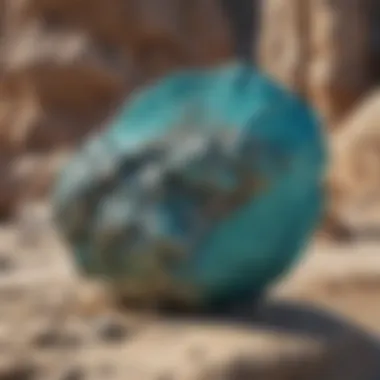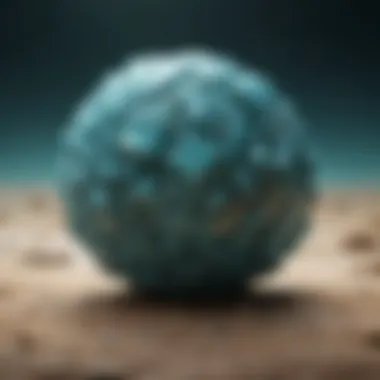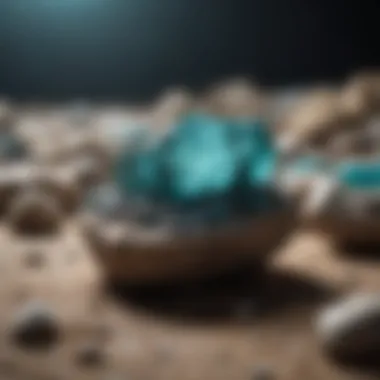Understanding the Market Price of Turquoise Gemstone


Intro
Turquoise is a captivating gemstone, treasured for its vivid color and rich historical significance. While its allure attracts many collectors, understanding its market price can be complex. Several factors come into play, from geological origins to market trends, and even authenticity checks. This article aims to equip rock and fossil enthusiasts with valuable insights on how to navigate the intricacies of turquoise pricing.
History and Origins
Overview of Collectibles, Rocks, and Fossils
Turquoise has been valued by various cultures worldwide for thousands of years. It often stands as a symbol of protection, wisdom, and prosperity. The stone forms through a process involving copper-rich minerals and is typically found in arid climates. Over the centuries, turquoise has appeared in jewelry, artifacts, and even in the insignia of various organizations. In terms of collectibles, turquoise ranks high due to its unique hues and varying grades.
Historical Significance and Cultural Impact
Different civilizations have held turquoise in high regard. The Egyptians adorned their tombs and jewelry with it, believing it to be a stone of life. Native American tribes used turquoise in ceremonies, often associating it with the sky and water. The value attributed to turquoise extends beyond aesthetics; it is woven into the fabric of cultural identities. Such historical importance adds another layer to its market value.
Identification and Classification
Guide to Identifying Rocks and Fossils
To properly assess turquoise, one must first learn the basics of identification. Genuine turquoise usually exhibits a waxy texture and vibrant color, often ranging from sky blue to greenish hues. One quick way to tell if a piece is real is to observe its color variations and matrix. Unlike imitation stones, authentic turquoise features unique veining patterns.
Common Types and Variations
Turquoise exists in various forms, each contributing to its overall value. Some common types include:
- ** Persian Turquoise**: Known for its rich blue color, often considered the highest quality.
- Sleeping Beauty Turquoise: From Arizona, this type is admired for its bright, clear blue without a lot of matrix.
- Chinese Turquoise: Frequently used in lower-quality pieces, this turquoise can be less vibrant and may possess more matrix.
Each type carries distinct market values, influenced by color, matrix, source, and treatment.
"The value of turquoise is not just in its beauty, but also in its story and the craftsmanship that brings it to life."
Culmination
Foreword to Turquoise Pricing
Turquoise pricing is an essential topic for rock and fossil collectors and enthusiasts seeking to understand the nuances of this precious stone. Understanding the price is not merely about numbers; it encapsulates factors like quality, market demand, and cultural significance. Knowing how these elements interact can greatly assist both buyers and sellers in making informed decisions.
Definition of Turquoise
Turquoise is a blue-to-green mineral that is an opaque gemstone. It is often found in arid regions and is one of the oldest known gemstones used by humans. The unique color is attributed primarily to the presence of copper and aluminum in its structure. Turquoise can be found in several places around the world, including the United States, Iran, and China. It has been valued for its beauty and is considered a symbol of protection and good fortune in many cultures.
Cultural Significance and History
The history of turquoise dates back thousands of years. It has played a significant role in the artifacts of ancient civilizations, such as the Egyptians and Aztecs. In Native American cultures, turquoise is often viewed as a sacred stone. It is worn for both decorative and spiritual reasons. With its deep historical roots, the value of turquoise is not simply in its physical presence but also in the stories and traditions it embodies.
"Turquoise is not just a gemstone; it is a bridge between cultures and history that can deeply influence its market value."
Understanding how history intertwines with the pricing of turquoise provides insight into its current market behavior. As demand grows based on cultural appreciation, prices can adjust accordingly, which makes the understanding of its pricing more dynamic and layered.
Factors Affecting the Price of Turquoise
Understanding the factors that affect the price of turquoise is crucial for collectors and enthusiasts alike. The market for turquoise is influenced by various elements, including its quality, source, and market demand. Each aspect contributes to the overall value and determines how a piece is perceived in the marketplace.
In this section, we will explore key areas such as quality and grade, geological sources, market demand, and authenticity. By delving into these factors, readers can make more informed decisions when purchasing or collecting turquoise.
Quality and Grade
Quality and grade are fundamental in defining the value of turquoise. These attributes play a significant role in what collectors are willing to pay. Each characteristic of turquoise contributes to its desirability and market appeal.
Color


Color is perhaps the most recognized quality of turquoise. The most sought-after hues are vivid blues and greens. These colors are appealing for both their aesthetic value and rarity. A vibrant blue, for instance, is generally favored due to its association with higher quality. One unique feature of color is that it can shift depending on the lighting which may confuse buyers.
However, not all colors hold the same market value. Less vibrant hues may be more affordable, but they lack the visual impact, making them a less desirable choice.
Pattern
The pattern found in turquoise is another critical factor influencing its price. Turquoise can present in swirls, veins, or a more uniform appearance. Unique or intricate patterns often elevate the value, appealing to collectors who appreciate individuality.
Some patterns can also suggest the origin of the stone. For instance, a spiderweb pattern can indicate specific mines, thus enhancing its desirability. Yet, not every pattern will have the same impact, as collectors may prefer certain types over others.
Clarity
Clarity in turquoise relates to the absence of inclusions and other blemishes. Higher clarity translates to a better rating in terms of quality. Pieces with minimal imperfections are priced higher because they are seen as more precious.
A unique feature of clarity is how it can affect the appearance of color. If a stone is cloudy, it can dull the richness of blue or green hues. As a result, collectors often seek clarity that maximizes color vibrancy, making clarity a key focus for buyers.
Hardness
Hardness speaks to the durability of turquoise. The Mohs scale is used to measure this attribute, with higher ratings signifying a stronger stone. A hardness rating of 5-6 often indicates good durability, making it suitable for jewelry.
While a softer stone might be easy to carve, it is more prone to damage, which can detract from its appeal. Consequently, purchasers often seek harder varieties that ensure longevity in wear.
Geological Sources
The geographic origins of turquoise heavily influence its price. Different sources bring varying characteristics, impacting market perception significantly. Regions known for producing high-quality stones are sought after, while lesser-known sources may struggle to gain traction in the market.
Domestic vs. International Sources
Domestic vs. international sources can greatly alter a stone's price. For instance, turquoise from the United States may fetch a higher price due to brand recognition and historical significance.
International sources like Iran or China also offer unique characteristics influencing pricing. Some collectors prefer stones from specific countries, believing they hold particular qualities. However, buyers must exercise caution, as international sourcing can sometimes lead to misunderstandings about authenticity.
Reputation of Mines
The reputation of mines plays an essential role in the value assignment of turquoise. Established mines are frequently associated with higher quality stones that come with a pedigree.
Mines with a longstanding tradition of producing exceptional turquoise often see more interest from collectors. However, the closure of mines or reports of fading quality can dampen interest and impact prices.
Scarcity of Specific Varieties
Scarcity can infinitely elevate the value of turquoise. As certain varieties become rare, they capture the attention of collectors and investors.
For example, the Sleeping Beauty turquoise is famous for its striking blue color yet is becoming increasingly hard to find. It garners premium prices due to its limited availability. Collectors must be mindful that scarcity can inflate value regardless of the quality, making informed assessment vital.
Market Demand
Market demand can fluctuate based on trends and interest among jewelers and collectors. Understanding demand dynamics helps in anticipating potential price fluctuations in turquoise.
Trends in Jewelry
Current trends in jewelry impact how turquoise is valued. Jewelers often dictate style, and periods of high demand can see prices soar. Turquoise that aligns with current trends, such as being set in popular styles, will be more valuable.
The evolving nature of fashion ensures that demand for turquoise can shift; thus, it is essential to stay updated on jewelry trends for potential investments.
Collector Enthusiasm
The enthusiasm of collectors also greatly affects the pricing of turquoise. A growing base of passionate collectors can drive prices up rapidly, especially for specific varieties.
Enthusiastic communities can elevate awareness around particular types of turquoise, affecting desirability and, consequently, market price. Conversely, waning interest can cause prices to stagnate or decline.


Artisan Craftsmanship
Artisan craftsmanship remains a significant driver of demand. Unique, handcrafted pieces often carry premium pricing due to the skill and effort involved.
The distinctiveness of artisanal work may command a higher price, as collectors often seek original artwork representing a specific aesthetic. However, the high price point can deter casual buyers, leading to fluctuating market dynamics.
Authenticity and Certification
As turquoise has a wide market presence, distinguishing authentic pieces from imitations is crucial. Authenticity ensures that collectors and buyers understand what they are purchasing, impacting perceived value.
Signs of Imitation
Identifying signs of imitation is vital to avoid overpaying. Common imitations like dyed howlite or resin can mimic the appearance of turquoise but lack the distinct properties.
Buyers should be aware of factors like color consistency and texture that might indicate whether a piece is genuine or fake. Developing a keen eye assists buyers in securing valuable pieces.
Role of Appraisers
Certified appraisers offer valuable services by providing professional opinions on turquoise value. Their assessments can help clarify worth and ensure authenticity.
An appraiser’s insights can be crucial for both buyers and sellers, offering guidance that aligns with current market conditions. However, depending on the appraiser's credibility is essential for accurate evaluations.
Certifying Bodies
Certifying bodies play a significant role in the authenticity of turquoise. Organizations often issue certification to confirm the legitimacy of gemstones.
Such certificates can increase buyer confidence, reflecting a level of quality assurance. However, certifying processes may vary, underscoring the need for thorough research to understand the standards utilized when assessing turquoise.
Different Forms of Turquoise
Understanding the different forms of turquoise is crucial for anyone involved in buying or collecting this gemstone. Different forms can significantly impact pricing and overall value. The two main categories are natural and stabilized turquoise. Knowing these distinctions helps collectors make informed decisions in a complex market.
Natural vs. Stabilized Turquoise
Natural turquoise comes directly from the earth without any alterations. It is valued for its unique color and characteristics. Pieces of natural turquoise are often rarer but come with higher price tags. Collectors tend to prefer this form because of its authenticity. Moreover, natural turquoise usually shows the distinct patterns that can be quite appealing.
In contrast, stabilized turquoise undergoes a process to enhance its color and durability. Stabilization prevents the stone from absorbing moisture and improves its hardness. This process can make lower-quality specimens more appealing to buyers. Although stabilized turquoise can be more affordable, it lacks the same collector value as natural stones. In general, buyers should consider their objectives: if they seek beauty, natural may be preferable; if durability is vital, stabilized will suffice.
Turquoise in Jewelry
Jewelry-making involves intricate designs where turquoise plays a key role. The way a piece is set enormously affects its pricing and desirability. Understanding these settings and designs is essential for any collector or enthusiast.
Settings and Designs
The choice of settings directly influences how turquoise is perceived in jewelry. Common settings include bezel settings, where the stone is surrounded by metal, and prong settings that allow light to hit the stone from multiple angles. Bezel settings often provide better protection for softer stones, while prong settings can make the stone appear larger and brighter.
A unique characteristic of settings is their compatibility with various jewelry styles. Modern, minimalist designs can highlight the turquoise’s natural beauty, while traditional styles may incorporate more intricate metalwork. These creative expressions can significantly impact pricing. High-quality craftsmanship and appealing designs tend to demand higher prices, making it important for buyers to consider the design features of a piece of jewelry.
Impact on Pricing
The impact of turquoise settings on pricing cannot be overstated. A well-designed piece can command a premium, positioning it as both a work of art and a collectible item. Intricate designs that showcase the stone's beauty can enhance its market appeal. This aspect is beneficial for collectors who wish to invest wisely.
The unique feature of impact on pricing lies in the relationship between craftsmanship and consumer preference. Higher-priced pieces often reflect superior materials and designs, influencing buyer decisions. Without a doubt, the setting not only protects the stone but also makes a strong statement about its value and place in the market.
Exceptional settings are as important to turquoise as the stone itself. A well-crafted piece can elevate turquoise and create significant market value.
Through this overview of different forms of turquoise and their applications in jewelry, collectors gain an informed perspective on what to look for and how to evaluate potential purchases. The interplay between natural vs. stabilized turquoise and the settings they are placed in reveals much about their value on the market.
Current Market Trends


The discussion about current market trends for turquoise is pivotal for understanding its financial landscape and potential as an investment. These trends highlight how the market is responding to factors such as supply, demand, and broader economic conditions, which, in turn, influences pricing strategies and investment decisions. For individuals interested in acquiring turquoise, awareness of market trends can help gauge when to make purchases or divest assets.
Recent Price Fluctuations
Recent trends indicate that the prices of turquoise can vary dramatically based on various influences. The gemstone has seen periods of rapid price increase followed by corrections, reflecting its volatile nature. Factors contributing to these fluctuations include:
- Market Demand: As interest in turquoise jewelry rises, especially in fashion and artisan circles, the demand spikes, often leading to higher prices.
- Supply Chain Issues: Mining conditions and geopolitical factors in regions rich in turquoise can disrupt supply, thus affecting prices.
- Certification and Authenticity Concerns: Prices can drop sharply for stones without proper certification or that are proven to be imitation.
Those pondering investment in turquoise should track these fluctuations closely. Observing when the market is poised for a correction or surge can offer valuable insights to act wisely.
Investment and Speculation
Interest in turquoise investment has grown as it is not just an ornamental stone but also a collectible asset. Investors and collectors are increasingly viewing turquoise as a viable component of diverse portfolios. In this context, a few aspects warrant attention:
- Historical Value: Turquoise has been valued for centuries and has a strong cultural significance, contributing to its long-term worth. Collectors often seek stones from reputable sources, believing they will hold or increase value over time.
- Speculative Buying: Some investors purchase turquoise with the hope that future trends will drive up prices. This speculation involves understanding market trends and being able to identify pieces that may appreciate.
- Resale Potential: Many collectors consider not just the joy of ownership but also the possibility of selling stones in the future for a profit.
"Investing in turquoise is not without risk. Always conduct thorough research and consult experts to assess market dynamics."
By staying informed about current market trends, collectors and investors can make well-rounded decisions about their turquoise ventures.
Guidelines for Buyers and Collectors
Buying turquoise can be a nuanced endeavor. It involves understanding the factors that influence prices and identifying quality pieces. This is crucial for ensuring that both collectors and buyers make informed decisions. From determining fair value to knowing where to purchase, the guidelines offered in this section aim to simplify the process.
Determining Fair Value
Determining fair value for turquoise is foundational for buyers. Each piece has unique qualities that affect its price. Assessing color, clarity, and origin helps estimate value accurately. Good practices include comparing similar items and consulting experts. When determining price, consider whether the piece is natural or stabilized. Natural turquoise tends to be of higher value due to its rarity. Additionally, understanding the current market trends can help buyers avoid overpaying.
Where to Buy Turquoise
Reputable Dealers
Buying from reputable dealers offers a significant advantage. They usually provide authentic stones with clear provenance. One key characteristic of reputable dealers is their transparency. They often share details about the stone's origin and treatment. It's beneficial for buyers because it builds trust, ensuring the purchase is genuine. Moreover, these dealers often have a return policy, which can help in case the item does not meet expectations. Overall, this approach minimizes the risk associated with buying turquoise.
Online Auctions
Online auctions present a unique opportunity for collectors. They often feature a variety of turquoise stones, providing broader choices. The key characteristic of online auctions is competitive bidding, which can lead to lower prices. For many, this aspect makes it a popular option. However, buyers must proceed with caution, as the authenticity of stones can vary. Reading reviews of sellers and understanding auction terms is essential before making bids.
Care and Maintenance
Proper care and maintenance extend the life of turquoise items. This ensures that their beauty and value are preserved. Buyers should prioritize learning about the cleansing methods suitable for turquoise, as improper care can damage the stone.
Cleansing Methods
Cleansing methods are crucial for maintaining the integrity of turquoise. A key aspect is to avoid harsh chemicals. Instead, simply using a damp soft cloth is often sufficient. This approach is popular due to its ease and effectiveness. Regular cleaning can help retain the stone's luster, making it more appealing. However, excessive moisture can harm the stone, so moderation is essential.
Storage Recommendations
Storage recommendations play a vital role in protecting turquoise. A major characteristic of proper storage is the environment in which the stones are kept. Storing turquoise in a dry, cool place will prevent damage. Using individual pouches or boxes can protect the stones from scratches. This method is beneficial as it minimizes direct contact with other jewelry, which can degrade their value over time. Additionally, it ensures each piece stays in optimal condition.
Culmination
The exploration of turquoise pricing reveals a multifaceted landscape shaped by various elements. Understanding this topic is vital, especially for collectors and enthusiasts in the rock and fossil communities. Knowledge about turquoise can significantly influence buying and selling decisions, ensuring that transactions are fair and informed.
Summary of Key Points
- Quality and Grade: The color, pattern, clarity, and hardness of turquoise play a major role in its pricing. Higher quality stones command greater prices, while imperfections can lower value.
- Geological Sources: The origin of turquoise affects its desirability. Turquoise from renowned mines is often seen as more valuable. Additionally, some varieties are rare, adding to their worth.
- Market Demand: Current trends in jewelry and collector enthusiasm can cause fluctuations in pricing. Artisan craftsmanship also contributes positively to market demand, driving prices higher for unique or custom pieces.
- Authenticity and Certification: Buyers should prioritize purchasing authenticated stones. Knowledge of signs of imitation and the roles of appraisers and certifying bodies is crucial in determining genuine pieces.
The Future of Turquoise Pricing
Looking ahead, the price of turquoise may continue to evolve due to various factors:
- Increasing Awareness: As interest in gemstone collecting grows, so does the awareness of turquoise among new enthusiasts. This may lead to an increase in demand, which can elevate prices over time.
- Sustainability and Mining Practices: Collectors are becoming more mindful of ethical considerations, influencing their purchasing choices. Mining practices and environmental issues could impact supply, thus affecting prices.
- Market Speculation: The potential for investment in turquoise as a commodity may drive prices. Market speculators' interest can lead to sudden price changes, making it essential to stay informed about market trends.
As we move forward, keeping close attention to these factors will help collectors navigate the complexities of turquoise pricing effectively.



